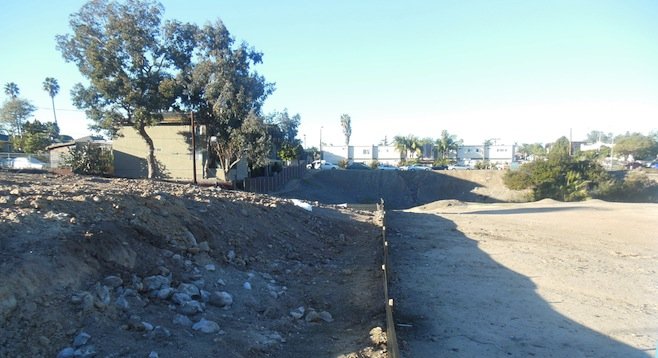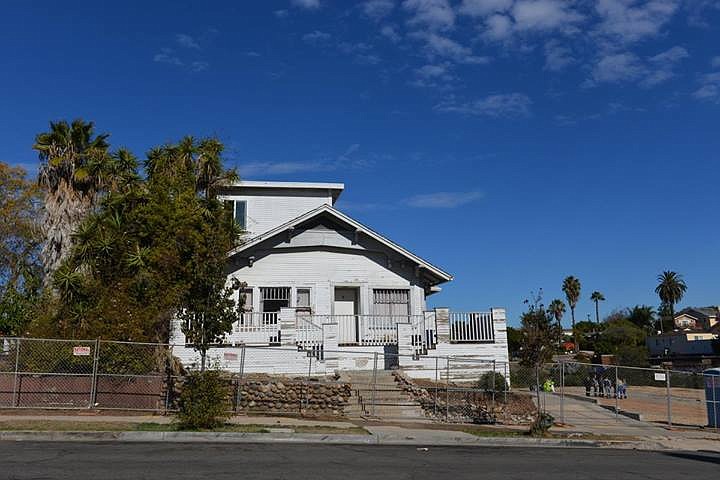 Facebook
Facebook
 X
X
 Instagram
Instagram
 TikTok
TikTok
 Youtube
Youtube

Where 29th meets B Street, in a quiet part of Golden Hill, a previously undeveloped, narrow green canyon will soon be the site of 27 new homes. The canyon, which for many years included the unpaved right-of-way for 29th Street, is one block wide and half a block long, with a deep ravine. Most of the homes will be built on the south side of the canyon, fronting C Street. There will also be a row on B Street, and the two sides of the development will be connected by a bridge that spans the ravine.

Jeffrey Peterson of the city’s Development Services Department stated in an email that the Golden Hill Row Homes engineering drawings were just approved on March 7 and the city was getting ready to issue the permits. Grading has started, and the undeveloped canyon had its first water and sewer pipes, cable connections, and electricity installed in late 2013. Work has not begun on the structures.
Before utilities could be added and construction could begin in the canyon, developers had to meet a series of requirements in accordance with the California Environmental Quality Act. A study had to be commissioned to identify potential environmental impacts. According to the project report filed by Peterson in 2007, the study found that the area does contain environmentally sensitive lands and is part of a soil layer “well-known for its rich fossil beds.”
In addition, the construction is in close proximity to an archaeological site where a deposit of early 20th-century industrial trash was found in 1998. A heavy equipment wheel, horseshoes, and other blacksmithing equipment were among artifacts found preserved in a heap of slag-like material. As a result of these findings, builders working in the canyon must be careful of the detritus left behind by their counterparts 100 years ago.

Golden Hill Row Homes broke ground in December 2013 with the demolition of two 1920s homes on the flattest part of the lot near the edge of the canyon. The home closest to the canyon edge, a two-story bungalow with a large addition in the back and an oversized porch, was most notable for the large, sturdy, river rock wall that wrapped around the front and side of the property.
The wall, dating to the early 1900s, was made of big, oval stones that were worn smooth by being at the bottom of a riverbed. The stones most likely came from the San Diego River and other nearby creeks and streams, and maybe even from the canyon itself. Cement was worked into the voids between the rocks to strengthen the wall. Many retaining walls like this were built around San Diego in the early 1900s—this one helped keep the property from eroding down the slope into the canyon.
Unlike others nearby — like the more famous 32nd Street Canyon and the Fir Street Canyon next to the Dog Park — the little B/C Street canyon does not have any organized opposition to its development. Several years ago, Tershia d’Elgin, a Golden Hill resident and canyon activist, did have a chance to analyze any impact the developer’s plans for the canyon might have on drainage and storm water. But the final project report stated that water quality and several other environmental factors “were considered and determined not to be significant.” Upon learning that work had begun on the canyon, d’Elgin recommended it for a native-plant restoration under a special “call for water quality projects” by the County of San Diego Watershed Protection Program. With native plants in place, the canyon would still provide a small but significant amount of storm-water drainage for the neighborhood.
The B/C Street canyon remained undeveloped until now most likely because of its steep gradient and the damp ravine that runs through it. When the city improved other streets in the neighborhood beginning in the early 1900s, the canyon was most likely too expensive to grade, pave, bridge, or to fill with dirt. Thus, the city left 29th Street unpaved through there, leaving the canyon as open space for many years while the lots around it filled up with homes and condominiums. In 1989, the city vacated its right-of-way for the street, creating the opportunity for development.
In 2007, the Greater Golden Hill Planning Committee voted unanimously to pass the project. Committee chair Ruchelle Alvarez did not comment for this story.

The design of Golden Hill Row Homes won the “Best on the Boards Multi-Family Projects” award in 2010. Features include solar panels that developers hope will generate 50 percent of the electricity used by residents and a private park. Richard Montaño, landowner, investor, and one of the developers on this project, expects the units to sell for between $600,000 and $700,000 each.
Montaño’s investment firm LIV Capital has put $2 million into the project, and his real estate firm Fit Properties will manage sales. Presidio Residential Capital, another local company, has invested $18.8 million. The developers hope to have a model ready in July or August, though construction is still in the preliminary phases.
Montaño said he has “received quite a bit of support” from the community. He said the interest list is “growing at about 10 new parties per day” and that he has been approached by potential buyers.


Where 29th meets B Street, in a quiet part of Golden Hill, a previously undeveloped, narrow green canyon will soon be the site of 27 new homes. The canyon, which for many years included the unpaved right-of-way for 29th Street, is one block wide and half a block long, with a deep ravine. Most of the homes will be built on the south side of the canyon, fronting C Street. There will also be a row on B Street, and the two sides of the development will be connected by a bridge that spans the ravine.

Jeffrey Peterson of the city’s Development Services Department stated in an email that the Golden Hill Row Homes engineering drawings were just approved on March 7 and the city was getting ready to issue the permits. Grading has started, and the undeveloped canyon had its first water and sewer pipes, cable connections, and electricity installed in late 2013. Work has not begun on the structures.
Before utilities could be added and construction could begin in the canyon, developers had to meet a series of requirements in accordance with the California Environmental Quality Act. A study had to be commissioned to identify potential environmental impacts. According to the project report filed by Peterson in 2007, the study found that the area does contain environmentally sensitive lands and is part of a soil layer “well-known for its rich fossil beds.”
In addition, the construction is in close proximity to an archaeological site where a deposit of early 20th-century industrial trash was found in 1998. A heavy equipment wheel, horseshoes, and other blacksmithing equipment were among artifacts found preserved in a heap of slag-like material. As a result of these findings, builders working in the canyon must be careful of the detritus left behind by their counterparts 100 years ago.

Golden Hill Row Homes broke ground in December 2013 with the demolition of two 1920s homes on the flattest part of the lot near the edge of the canyon. The home closest to the canyon edge, a two-story bungalow with a large addition in the back and an oversized porch, was most notable for the large, sturdy, river rock wall that wrapped around the front and side of the property.
The wall, dating to the early 1900s, was made of big, oval stones that were worn smooth by being at the bottom of a riverbed. The stones most likely came from the San Diego River and other nearby creeks and streams, and maybe even from the canyon itself. Cement was worked into the voids between the rocks to strengthen the wall. Many retaining walls like this were built around San Diego in the early 1900s—this one helped keep the property from eroding down the slope into the canyon.
Unlike others nearby — like the more famous 32nd Street Canyon and the Fir Street Canyon next to the Dog Park — the little B/C Street canyon does not have any organized opposition to its development. Several years ago, Tershia d’Elgin, a Golden Hill resident and canyon activist, did have a chance to analyze any impact the developer’s plans for the canyon might have on drainage and storm water. But the final project report stated that water quality and several other environmental factors “were considered and determined not to be significant.” Upon learning that work had begun on the canyon, d’Elgin recommended it for a native-plant restoration under a special “call for water quality projects” by the County of San Diego Watershed Protection Program. With native plants in place, the canyon would still provide a small but significant amount of storm-water drainage for the neighborhood.
The B/C Street canyon remained undeveloped until now most likely because of its steep gradient and the damp ravine that runs through it. When the city improved other streets in the neighborhood beginning in the early 1900s, the canyon was most likely too expensive to grade, pave, bridge, or to fill with dirt. Thus, the city left 29th Street unpaved through there, leaving the canyon as open space for many years while the lots around it filled up with homes and condominiums. In 1989, the city vacated its right-of-way for the street, creating the opportunity for development.
In 2007, the Greater Golden Hill Planning Committee voted unanimously to pass the project. Committee chair Ruchelle Alvarez did not comment for this story.

The design of Golden Hill Row Homes won the “Best on the Boards Multi-Family Projects” award in 2010. Features include solar panels that developers hope will generate 50 percent of the electricity used by residents and a private park. Richard Montaño, landowner, investor, and one of the developers on this project, expects the units to sell for between $600,000 and $700,000 each.
Montaño’s investment firm LIV Capital has put $2 million into the project, and his real estate firm Fit Properties will manage sales. Presidio Residential Capital, another local company, has invested $18.8 million. The developers hope to have a model ready in July or August, though construction is still in the preliminary phases.
Montaño said he has “received quite a bit of support” from the community. He said the interest list is “growing at about 10 new parties per day” and that he has been approached by potential buyers.
Comments